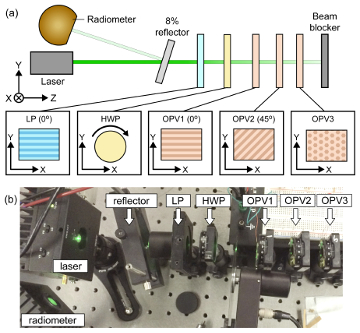
The NCSU optoelectronic polarimeter design uses three organic photovoltaics (OPV1, OPV2 and OPV3) to gain information about individual components of the Stokes vector, which are then computationally modeled to determine the beam’s linear polarization. The additional linear polarizer (LP) and half-wave plate (HWP) in the setup above are used for calibrating device. [Image: Gupta Roy et al., Opt. Express, doi: 10.1364/OE.24.014737]
A research team at North Carolina State University (NCSU), USA, has taken “an optoelectronic approach” to developing a compact polarimeter. The approach uses a three-layer stack of semitransparent, strain-aligned polymer organic photovoltaics (OPVs) to suss out polarization rapidly in a single-beam measurement (Opt. Express, doi: 10.1364/OE.24.014737).
The group’s proof-of-concept device already shows measurement errors as low as 1.2 percent. And the team’s lead investigator, OSA Member Michael Kudenov, is optimistic that improvements in the device design could hammer those errors down still further—allowing for new, compact and high-resolution polarimeters competitive with the best detectors now on the market.
Toward a single-beam approach
Compact polarimeters have potential applications in a wide range of areas, from remote sensing to biomedical imaging. But many existing polarimeters tend to be bulky and complex to use or to have limited accuracy. Current compact designs, for example, often require taking multiple light samples at different times or at different points in space, which limits the spatial resolution of the measurement.
To get around these drawbacks, Kudenov’s team began by noting that in principle, only three measurements are required to specify a light beam’s linear polarization—as specified by the first three components of the so-called Stokes vector, which describes the beam’s total polarization. (The fourth Stokes vector component is tied to the beam’s circular polarization.) Thus, if the same beam could be passed sequentially through three different detectors, each taking a measurement that supplied one Stokes vector component, the result could be built into a very compact polarimeter—with a potentially much better spatial and temporal resolution than approaches that sample multiple beams.
Strained polymers
The NCSU researchers realized that semitransparent OPVs, strained in such a way to give them a preferred angular orientation, might be just the ticket for such a “cascaded” polarimeter. They created a set of three polymer OPV films, two of which were subject to uniaxial strain during cooling—to orient the photoactive layer in ways to that made it preferentially aborb light oriented at polarizations of 0 and 45 degrees, respectively—and one of which was unstrained and isotropic.
They then set the films into a stacked array, and illuminated them with a single beam of 532-nm laser light. As the single beam passed through each of the three semitransparent OPVs, the absorbed photons at a given polarization created a photocurrent that was read off of the OPV and tied to the relevant Stokes vector component. The three measurements were then funneled into a computer model that allowed the light’s overall polarization to be read out.
Multiple applications envisioned
Because it performs all three required polarization measurements on the same incident beam in a compact setup, the NCSU researchers say, the technique can yield both better spatial registration and higher resolution in time than approaches requiring multiple measurements. The team’s test runs showed that the proof-of-concept device could achieve measurement errors as low as 1.2 percent. That number, Kudenov admits, is “not as good as the best polarization detectors currently on the market.” But, he says “we’re really just getting started,” and he’s optimistic that design improvements will push down the measurement errors to competitive levels.
Once that’s done, the team believes that compact polarization detectors based on its method could find use in a wide variety of settings, ranging from defense and security to atmospheric monitoring and research.
